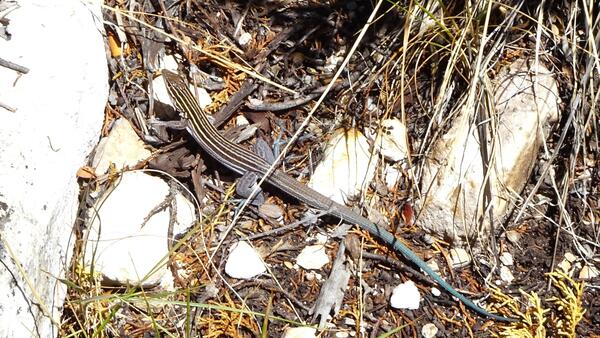On parthenogenic whiptail species
“Biologically a species is the accumulation of the experiments of all its successful individuals since the beginning.” — H.G. Wells
By CAMERON BARROWS
There are several definitions of “what is a species,” but all of them are filled with exceptions. The most common definition, the Biological Species Concept, focuses on sexual reproduction: if two individuals can mate and create viable offspring that can continue that genetic lineage (are fertile) then they are of the same species. If not, they are different species. Horses and burros can mate and produce viable offspring, but those offspring (mules) are almost always sterile and so cannot continue their lineage. Different species.
One problem with this definition is with isolated populations that are separated by insurmountable barriers, oceans, mountains, or, for sand dune species, landscapes that are not sand dunes. Such populations are clearly on different evolutionary trajectories, and so appear to be different species. However, those barriers mean that they can never take that species litmus test of whether they could, if the barriers disappeared, breed and produce viable, fertile offspring. With today’s technology, DNA, population genomes can be compared and if found distinct, can be called different species. Or there is the common sense approach: “If it looks like a duck and quacks like a duck, it’s a duck, otherwise it is a goose or a swan.”
Across the California deserts we have just one species of whiptail lizard, the western or tiger whiptail, Aspidoscelis tigris. They have a distinct look and behavior that makes identification easy. They are ground-based, almost never climbing boulders, and never climbing trees or shrubs. Their tail, if intact, is clearly longer than their body, and unless sunbathing, they are constantly on the move searching for their next meal of termites or side-blotched lizards. Those jerky moves, pause-move-pause-move, and then repeat, are diagnostic. In contrast, across Arizona there are 10 whiptail species, and New Mexico has 13. While these states have a richness of whiptails, for naturalists it can be a challenge to distinguish one species from another. Many have longitudinal stripes, and the species diagnostics include whether they have six or seven stripes, whether there are faint dots between the stripes, and whether the midline stripe is solid, wavy, or broken. All need to be assessed while the lizards are constantly moving.
Such identification challenges can spark lively, usually friendly debates between naturalists: “Was that a Gila spotted whiptail, or a Sonoran spotted whiptail, a desert grassland whiptail, or a plateau striped whiptail?” As the debate ensues the lizard disappears into the vegetation. While these debates can be entertaining, what is more interesting is that apparently the whiptails cannot always tell the difference either. The results of such mistaken identities can be hybrids between two different whiptail species.
What is even more interesting is that these hybrids are not always sterile; they are, however, always female and are parthenogenic. Being parthenogenic means that these female lizards create viable offspring without the addition of a male contributing his half to the hatchlings’ DNA. The female produces eggs with a complete compliment of DNA, not just half. The offspring are essentially clones of the female. There are anecdotal accounts from observing captive lizards that their reproductive cycle is stimulated by pseudo copulations among these all-female populations. These clonal whiptails form healthy populations, and despite not fitting into any standard species definition, are named as distinct species. For Arizona, five of their 10 whiptail species are entirely comprised of parthenogenic females; for New Mexico, nine of their 13 species are parthenogenic females.

These all female, clonal populations bring up another question. There is ample evidence that genetic diversity is a key to the species richness of our planet. Across scales of both time and space, our planet has always been in a state of change. Usually that change has taken place over tens or hundreds of thousands of years, or longer. Imperceptible changes for individuals but important changes for species. Within the genetic diversity of a species, some will be incrementally better adapted to those changes, and those individuals will leave more offspring. That’s natural selection. The question then is if there is no genetic diversity between individuals of a population, or of a species (clones), then there is no variability upon which natural selection can act, and result in higher fitness and resiliency to change. This question is particularly relevant to the abnormal and relatively rapid climatic changes we are now experiencing.
For a species, resiliency to environmental change can come from genetic changes yielding better tolerance to heat, aridity, and variability. Or resiliency can be achieved by shifting where a species lives, shifting to a place where the climate matches their existing physiological and behavioral repertoire. For clonal whiptails, in the absence of genetic exchange, that second option is their only hope. That hope then is dependent on ecological connectivity to higher elevations or higher latitudes. How the parthenogenic whiptail species will fare as organisms increasingly need to adapt to a changing habitat remains to be seen.
Nullius in verba
Go outside, tip your hat to a chuckwalla (and a cactus), think like a mountain, and be safe